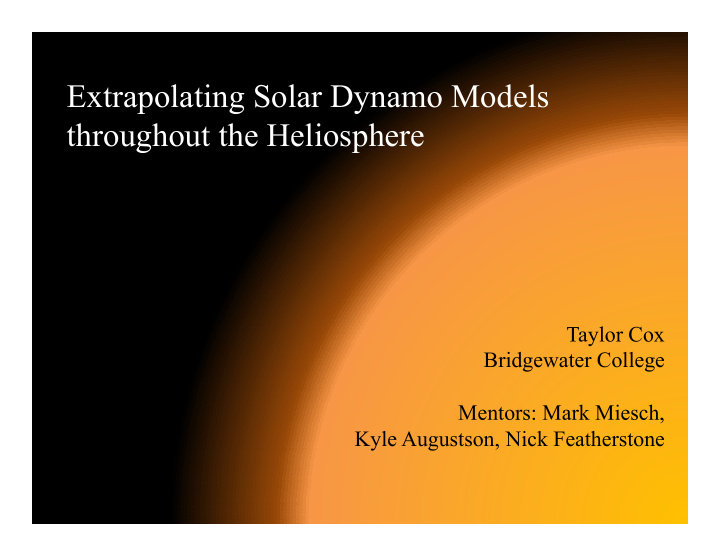



Extrapolating Solar Dynamo Models throughout the Heliosphere Taylor Cox Bridgewater College Mentors: Mark Miesch, Kyle Augustson, Nick Featherstone
Solar Convection • Convection arises from heat in the Sun rising up and cooling, then sinking to heat up and rise again. • This is manifested in the motion of plasma within the Sun’s convective zone. • The motion of this ionized plasma produces magnetic fields, and this full system is known as the solar dynamo.
The Necessity of Sunspots • The magnetic fields created from the solar dynamo are contorted by the differential rotation of the Sun. • The magnetic field is chaotically spread across the Sun’s surface in the “magnetic carpet” • The magnetic fields can also become concentrated and lead to the creation of sunspots.
Solar Dynamo Models The Convective Dynamo Model • Represents the fully nonlinear solution of the MHD equations for the solar convection zone • Lacks the development of • Computers about one magnetic fields attributed to million times faster than sunspot formation today’s should have the capacity to see sunspots appear in the model, keeping the model supported.
Babcock-Leighton Model • A kinematic dynamo model driven by sunspots • Sunspot reconnection at • Magnetic flows for the equator and dissipation this model are to the poles results in prescribed to obtain its polarity flipping at the poles effect, as opposed to the freely evolving convective model.
Solar Dynamo Simulations • The convective zone cannot be directly observed. • Supercomputer simulations of the Here, the supercomputer convective zone allow simulation ASH formed further modeling of the the data used. region. CASH models represent • These simulations can models of the Convective then be compared to the Dynamo, while BASH behavior of the Sun itself models represent models to determine the pros and of the Babcock-Leighton cons of a given model. Dynamo.
A CASH Simulation
A BASH Simulation
Current Limitations One key inconvenience: CASH and BASH only simulate data at the edge of the convective zone of the sun, while the behavior of the magnetic My job became to make fields they generate code that would throughout the extrapolate the heliosphere would be very simulation data to make useful in comparing that viewing possible. coronal consequences the two models.
Potential Field Source Surface Extrapolations • This method relies first and foremost on the assumption that there are no currents in space. • With this assumption, spherical harmonic transforms may be used to extrapolate the data from a particular source surface. This model of CASH data extrapolates the magnetic field out to 10 solar radii, where the field is predominately a dipole.
Power Spectra The ¡power ¡in ¡each ¡ spherical ¡harmonic ¡degree ¡ can ¡be ¡used ¡to ¡visualize ¡ the ¡complexity ¡ ¡of ¡the ¡ magne:c ¡field. ¡The ¡BASH ¡ model ¡data ¡is ¡represented ¡ in ¡blue, ¡and ¡the ¡CASH ¡data ¡ is ¡in ¡red. ¡ ¡
4 Solar Radii BASH CASH At 4 solar radii, complex field At 4 solar radii, field has become still visible, magnetic loops simplified, and already begins to indicative of sunspots. (Only exhibit dipole-like behavior. equatorial region shown).
2 Solar Radii CASH BASH The CASH model at 2 solar radii has At 2 solar radii, magnetic much more activity than is evident field is very much further away, as another layer of nonuniform, and patches of opposing magnetic can be seen opposing field indicative of pushing out from where there is just a sunspots may be seen. dipole farther out.
CASH Time-Evolving Data 4 Solar Radii At 4 solar radii, most The 4 radii cross-section also changes at the surface are shows a rather steady field, but already mitigated to a rather the more active internal field steady dipole. can be seen.
BASH Time-Evolving Data 4 Solar Radii The BASH data is very much The cross-section for the time evolving BASH inconsistent on the surface, as the data reveals more consistency, with a standard sunspot areas can be seen shape for the sunspot appearances being evident, everywhere. This being at 4 radii, and the overall effect at great distances shown BASH is still quite complex. here.
CASH Time-Evolving Data 2 Solar Radii At 2 solar radii the sun is clearly more dynamic Here the cross-sectional view with its closest field gaining and losing strength presents an excellent vantage point regularly, and the latitude where the two polarities of the magnetic behavior near the meet rising and falling. sun during a pole-reversal.
Results • The implementation of sunspots at the surface does in fact result in a more complex field throughout the heliosphere • The CASH model does not • As can be seen in data produce readily evident magnetic from 4 solar radii, the loops to be associated with CASH model falls into a sunspots, even near the surface, strong dipole field much as is to be expected from the closer to the Sun than does current technological limit faced the BASH model. by the convective model.
Recommend
More recommend